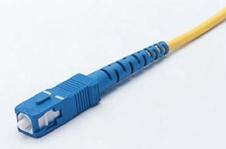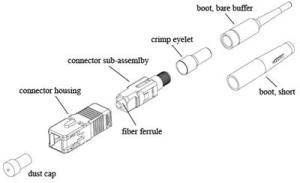More than a dozen types of fiber optic connectors have been developed by various manufacturers since 1980s. Although the mechanical design varies a lot among different connector types, the most common elements in a fiber connector can be summarized in the following picture. The example shown is a SC connector which was developed by NTT (Nippon Telegraph and Telephone) of Japan.
A SC Connector Sample
Elements in a SC connector
1. The fiber ferrule.
SC Connector Fiber Ferrule
SC connector is built around a long cylindrical 2.5mm diameter ferrule, made of ceramic (zirconia) or metal (stainless alloy). A 124~127um diameter high precision hole is drilled in the center of the ferrule, where stripped bare fiber is inserted through and usually bonded by epoxy or adhesive. The end of the fiber is at the end of the ferrule, where it typically is polished smooth.
2. The connector sub-assembly body.
The ferrule is then assembled in the SC sub-assembly body which has mechanisms to hold the cable and fiber in place. The end of the ferrule protrudes out of the sub-assembly body to mate with another SC connector inside a mating sleeve (also called adapter or coupler).
3. The connector housing
Connector sub-assembly body is then assembled together with the connector housing. Connector housing provides the mechanism for snapping into a mating sleeve (adapter) and hold the connector in place.
4. The fiber cable
Fiber cable and strength member (aramid yarn or Kevlar) are crimped onto the connector sub-assembly body with a crimp eyelet. This provides the strength for mechanical handing of the connector without putting stress on the fiber itself.
5. The stress relief boot.
Stress relief boot covers the joint between connector body and fiber cable and protects fiber cable from mechanical damage. Stress relief boot designs are different for 900um tight buffered fiber and 1.6mm~3mm fiber cable.


